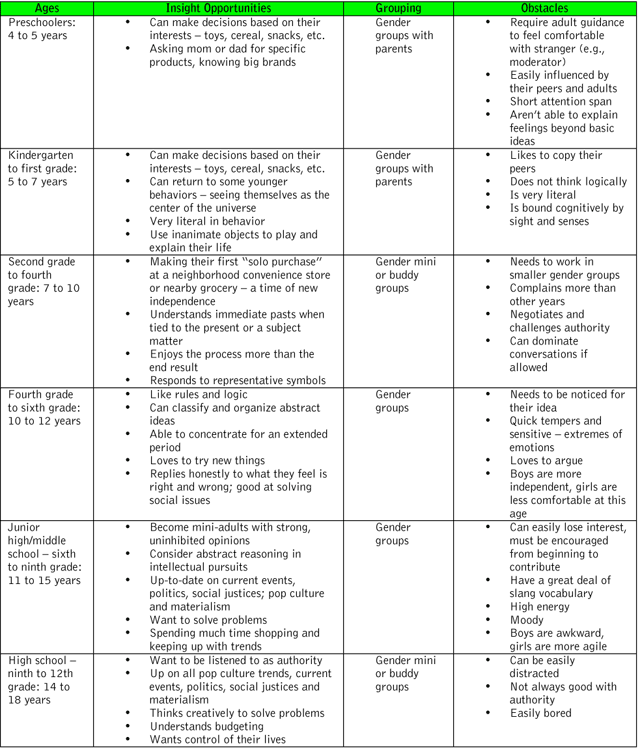From second grade forward
Editor’s note: Pam Goldfarb is a moderator with LitBrains-Igniting Ideas!, a Minneapolis research firm.
How young is too young for focus groups? Children are wonderful, uncensored consumers. It’s just important to understand their limits at each age so that you - the moderator - can encourage a fantastic experience for both your client and kid respondent.
The general consensus among many moderators working with kids is that second grade (age 7 or 8) is the perfect age. Please note that it is common practice to refer to children by school grade when talking about appropriate ages for focus groups. This is a great way to speak of a collective development stage for children, who are socialized in that context until they reach college age.
An estimated 25 percent of children in the U.S. or 20 million kids are growing up in single-parent households (U.S. Census Bureau). An estimated 80 percent of today’s U.S. families have both parents working - whether in the same household or not. In addition, these same children are watching much more than television to get their marketing messages, with as many as 1,725 brand impressions made on a typical child every day in mediums that vary from traditional television and radio to the Internet and even watching billboards on the road home or in the grocery store with mom (Kids Food and Beverage in the U.S., a marketresearch.com report).
There are several factors that make second grade a good age for kids to begin participating in focus groups independently (without mom or dad). By that stage, they are more comfortable with their peers and other people outside their immediate family. Thanks to a year or more of full-time school days under their belt they can pay attention to questions and comfortably share their ideas. Responding to a question is perhaps the basic job of a good focus group respondent, right?
Beware, though: Boys and girls do differ at this age. A general rule of thumb is to divide by gender and keep groups small for this age group. Boys are often more independent than girls, being allowed to travel down the street for quick errands with neighbors or riding their bikes. Girls don’t gain their independence from their parents until a year or so later, but don’t worry: They do have opinions. Keeping them in gender-specific smaller groups ensures that comfort levels will be quick and great insights will flow throughout.
Magical age
Fourth grade - the “senior” year of elementary school - is a transition time that moves kids from children to prepubescence. It’s a magical age that can be more difficult for some and easier for others. Girls differ greatly in this age group. Some are more appropriately paired with younger ages, while others fit perfectly among the fifth- and sixth-graders.
It isn’t until somewhere between fourth and roughly sixth grade when boys and girls are equally independent in how they confidently shop the aisles of a toy store or even a supermarket. Mom and dad are still a factor but kids have strong opinions and their parents listen. This is the age that they are aware of many brands and very strongly influenced by their peers. (Some children are more aware than others, but that is what makes this a very rich age to gain insights into their individualities.) It is also an enchanted age when they are acutely awake to their gender differences for obvious physical differences. Separating age groups is again an extremely important idea for this prepubescent age. The strongest reason is because boys heavily influence girls at this age. While boys aren’t aware of their influence, girls need to be made comfortable without the conflict of having a cute boy in the room. Puberty for girls is definitely around in this tween age - ages 9 to roughly 12 years.
We are strangers
As a focus group moderator, we need to realize that we are strangers to these kids and their parents until we make them feel comfortable. Most parents of children younger than second grade will not allow their kids to attend a focus group alone with a stranger - even if we try. There are ways to work with parents and children under second grade-age but they are not nearly as effective as the focus group. Children of that age will require creatively-designed discussions that involve clearly stated, concise questioning and involve their parent as encouragement.
With the more protective nature of parents in today’s society, a researcher should be careful to fully inform parents about the nature of the research in all screeners. Also, provide a letter prior to the groups clearly outlining the research purpose and nature of the activities in which their children will be participating. Make it comfortable for the child to speak their mind and allow the parent to understand what the interview is about and how their child’s insights will be used.

References
Yardsticks: Children in the Classroom Ages 4-14 : A Resource for Parents and Teachers by Chip Wood
The Kids Market: Myths and Realities by James U. McNeal
U.S. Census Bureau 2000
Kids Food and Beverage in the U.S. (2005), marketresearch.com.
